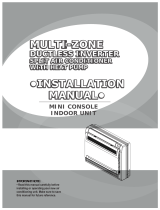
DRAIN PIPE CONNECTION
The fan coil is equipped with a drain hose. It is
tied together with the refrigerant piping. During
installation, it is important to observe the following
instructions to prevent water overflowing from the
drain pan.
! Insure that the indoor unit is level and not
tilted forwards or backwards.
! Insure that the drain hose does not rise
above the drain pan. It should be sloping
towards the hole.
! Route the drain hose through the same
hole as the refrigerant pipes.
! If the drain pipe extends horizontally a long
way, use PVC tubing to provide heat
insulation.
! Outside insert the drain hose into a PVC
drainpipe and not the other way around and
glue them together.
! Run the PVC drainpipe straight down the
wall. There should be no traps and avoid
putting the end of the pipe into water.
! Ensure that all sections of the PVC pipes
are glued securely together.
! Ensure that the entire indoor part of the
drain hose is insulated to avoid
condensation from dripping.
! Drain pipe may be required for heat pump
unit and should be connected if necessary.
SLIME
Water leakage due to a clogged drain hose can be caused by accumulated dirt in the drain pan or by
a buildup of slime inside the drain hose.
Slime is caused by the following factors:
! Temperature : 25°C (77°F) to 30°C(86°F)
! Accumulated water
! Nutrients (components of perspiration and dust in the air)
! A combination of certain types of mold and bacteria.
To reduce the chance of clogging, it is very important to ensure that the drain hose has a downward
slant to prevent water from accumulating and a clean and a well ventilated environment.
Down-
ward
slant
Drain Pipe
Downward
Slant
Drain Pipe
• Traps
Trap
The lack of a
downward
slope causes
water to build
up and
overflow the
drain pan.
Traps
Even if there is a downward slope overall,
there must not be any “double traps” formed
• Long Horizontal Extensions
Gap of approximately 50 cm
Good
Secure in place
with saddles
Stiff vinyl
chloride (PVC)
tubing
Trap effect created
Flexible tube
No good
Good
Drain hose
No good
Drain water cannot
flow freely
Drainage gutterDrainage gutter





















